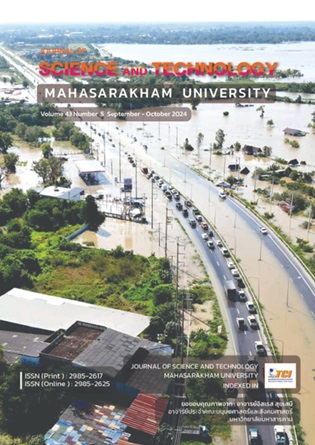การอนุรักษ์ในรูปแบบดิจิทัลของแหล่งซากดึกดำบรรพ์รอยตีนไดโนเสาร์แห่งแรกของประเทศไทยด้วยแบบจำลอง 3 มิติ จากเทคนิคโฟโตแกรมเมทรี
Main Article Content
บทคัดย่อ
ซากดึกดำบรรพ์รอยตีนไดโนเสาร์ที่มีการบันทึกไว้ครั้งแรกในเอเชียตะวันออกเฉียงใต้ถูกค้นพบในปี พ.ศ. 2527 รอยดังกล่าวถูกพบอยู่บริเวณผาสมเด็จในเขตรักษาพันธุ์สัตว์ป่าภูหลวง จังหวัดเลย ภาคตะวันออกเฉียงเหนือของประเทศไทย บริเวณดังกล่าวมีลักษณะเป็นแผ่นหินทรายจากหมวดหินภูพานของยุคครีเทเชียสตอนต้น และเป็นรอยตีนที่พบเพียงแหล่งเดียวจากยุคนี้ อย่างไรก็ตามบริเวณเส้นทางภูหลวงมีความเสี่ยงที่จะเสื่อมสภาพตามกาลเวลาเนื่องจากสภาพอากาศ สัตว์ และกิจกรรมของมนุษย์ การศึกษานี้มีวัตถุประสงค์เพื่อติดตามแผนการอนุรักษ์ในรูปแบบดิจิทัลโดยใช้แบบจำลอง 3 มิติที่สร้างจากเทคนิคโฟโตแกรมเมทรี แบบจำลองสามมิติที่ได้จากวิธีนี้สามารถเก็บข้อมูลพื้นผิว สี และแสดงผลลักษณะของตัวอย่างในช่วงเวลานั้นได้ ให้ผลที่ดีกว่าและง่ายต่อการนำมาใช้งานเมื่อเทียบกับวิธีการเดิม เช่น การทำพิมพ์รอยตีน แบบจำลองเหล่านี้ให้ข้อมูลรายละเอียดเพื่อการอนุรักษ์และส่งเสริมการสื่อสาร การทำงานร่วมกันทางวิทยาศาสตร์ การใช้โฟโตแกรมเมทรีช่วยให้การผลิตข้อมูลรวดเร็วและคุ้มค่า เป็นประโยชน์ต่อผู้เชี่ยวชาญและสาธารณชนในการอนุรักษ์และเผยแพร่ความรู้
Article Details
เอกสารอ้างอิง
Albertz, J. (2007). A Look Back 140 Years of “Photogrammetry” - Some Remakes on the History of Photogrammetry. Photogrammetric Engineering & Remote Sensing, 504–506.
Buffetaut, E., Ingavat, R., Sattayarak, N. & Suteethorn, V. (1985a). Les premières empreintes de pas de Dinosaures du Sud-Est asiatique. pistes de Carnosaures du Crétacé inférieur de Thaïlande. Comptes-Rendus de l’Académie des Sciences de Paris, 309, Série II. 643-648.
Buffetaut, E., Ingavat, R., Sattayarak, N. & Suteethorn, V. (1985b). Early Cretaceous Dinosaur Footprints from Phu Luang (Loei Province, Northeastern Thailand) and Their Significance. Conference on Geology and Mineral Resources Development of the Northeast, Thailand, (71-76). Khon Kaen University
Chatzi, E., Chatzistamatis, S., Soulakellis, N., & Zouros, N. (2017). 3D Modelling of Petrified Trees: Laser Scanning vs. Photogrammetry. IMEKO International Conference on Metrology for Archaeology and Cultural Heritage Lecce, October 23-25, 2017, Italy.
Cunningham, J. A., Rahman, I. A., Lautenschlager, S., Rayfield, E.J., & Donoghue, P.C.J. (2014). A virtual world of paleontology. Trends in Ecology & Evolution, 29(6), 347–357. https://doi.org/10.1016/j.tree.2014.04.004
Falkingham, P. L. (2012). Acquisition of high resolution three-dimensional models using free, open-source, photogrammetric software. Palaeontologia Electronica, 15(1), 1–15. https://doi.org/10.1371/journal.pone.0004532
Falkingham, P. L., Bates, K. T., Avanzini, M., Bennett, M., Bordy, E. M., Breithaupt, B. H., ... & Belvedere, M. (2018). A standard protocol for documenting modern and fossil ichnological data. Palaeontology, 61(4), 469-480.
Jansa, J., Studnicka, N., Forkert, G., Haring, A., & Kager, H. (2004). Terrestrial laser scanning and photogrammetry – Acquisitions techniques complementing one another, ISPRS 2004. Proceeding CD. Commission V, Istanbul.
Kozu, S. (2017). Dinosaur Footprints from the Khorat Group, Northeastern Thailand (Doctoral Program in Earth Evolution Sciences) the Graduate School of Life and Environmental Sciences, the University of Tsukuba
Lallensack, J. N., M. Buchwitz, & A. Romillo. (2022). Photogrammetry in Ichnology: 3D model generation, visualisation, and data extraction. Journal of Paleontological Techniques, 22: 1-18.
Le Loeuff, J., Saenyamoon, T., Suteethorn, V., Khansubha, S. & Buffertaut, E., (2005). Vertebrate Footprints of South-East Asia (Thailand and Laos): A review. In: Wannakao, L. (Ed.), Proceedings of the International Conference on Geology, Geotechnology and Mineral Resources of Indochina, Geoindo 2005. Khon Kaen University, Department of Geotechnology, pp. 582–587.
Le Loeuff, J., Suteethorn, V. & Buffetaut, E. (2006). The oldest mentions of fossil vertebrate footprints in Thailand: A reassessment of Bishop Pallegoix and Henri Mouhot’s writings. Ichnos, 13, 81– 86.
Lockley, M., Sato, Y. & Matsukawa, M. (2002). A new Dinosaurian Ichnogenus from the Cretaceous of Thailand. Proceedings of the Symposium on Geology of Thailand, Department of Mineral Resources, (117-119). Bangkok.
Lockley, M., Matsukawa, M. Sato, Y, Polahan, M. & Daorerk, V. (2006). A distinctive new theropod dinosaur track from the Cretaceous of Thailand: Implications for theropod track diversity. Cretaceous Research, 27, 139–145.
Lyons, P. D., Marc, R., & Patterson, T. (2000). Application of a three-dimensional color laser scanner to Paleontology. An interactive model of a juvenile Tylosaurus sp. basisphenoid-basioccipital. Palaeontologia Electronica, 3(2).
Mallison, H., & Wings, O. (2014). Photogrammetry in Paleontology – A practical guide. Journal of Paleontological Techniques, (12), 1–31.
Martínez-Fernández, A., Benito-Calvo, A., Campaña, I., Ortega, A. I., Karampaglidis, T., de Castro, J.M.B., & Carbonell, E. (2020). 3D monitoring of Paleolithic archaeological excavations using terrestrial laser scanner systems (Sierra de Atapuerca, Railway Trench sites, Burgos, N Spain). Digital Applications in Archaeology and Cultural Heritage, 19, e00156.
Petti Fabio Massimo, Petruzzelli, M., Conti, J., Spalluto, L., Wagensommer, A., Lamendola, M., Francioso, R., Montrone, G., Sabato, L., & Tropeano, M. (2018). The use of aerial and close-range photogrammetry in the study of dinosaur tracksites: Lower Cretaceous (upper Aptian / lower Albian) Molfetta ichnosite (Apulia, southern Italy). Palaeontologia Electronica, 21(3), 1–18.


